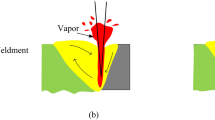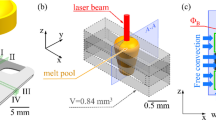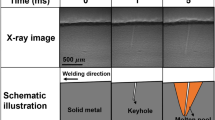Abstract
Laser beam welding is widely used in various industrial applications due to its low production cost, high efficiency, and fast production capabilities. It is essential to understand the melt pool and the temperature distribution in the laser source impact region to improve the laser beam welding quality. In this study, an analytical model based on the “eigenfunction expansion” method was developed to determine the melt pool geometry and temperature distribution in the heat-affected zone (HAZ) during laser beam welding. Also, the welding process experimentally was applied to AISI 430 ferritic stainless at 225, 375, and 525 W laser powers for 0.6 and 0.9 mm layer thicknesses. Melt pool geometries formed as a result of welding were determined by a laser microscope and compared with an analytical study. The maximum deviation between the analytical and experimental results was found to be 18%. Additionally, the temperature distribution in the HAZ was analyzed for the same parameters. Based on the results, it was observed that the proposed analytical model provides a cost-effective and time-efficient alternative to numerical and experimental methods for predicting the quality of laser beam welding.











Similar content being viewed by others
Abbreviations
- \(C_1\) :
-
Constant
- \(C_2\) :
-
Constant
- \(h\) :
-
Heat transfer coefficient (Wm−2 K−1)
- \(i\) :
-
Eigenvalue
- \(k\) :
-
Thermal conductivity (Wm−1 K−1)
- \(q\) :
-
Heat source
- \(L_x\) :
-
X directional length (mm)
- \(L_y\) :
-
Y directional length (mm)
- \(P\) :
-
Laser power (W)
- \(R\) :
-
Laser radius (mm)
- \(S_1\) :
-
Constant
- \(S_2\) :
-
Constant
- \(T\) :
-
Temperature (K)
- \(y\) :
-
Direction
- \(x\) :
-
Direction
- \(\eta\) :
-
Absorptivity
- Δ:
-
Difference
- ρ :
-
Density, kgm−3
- \(\theta\) :
-
Dimensionless temperature
- \(\phi\) :
-
Y Dependent function
- \(\Theta\) :
-
Y Dependent function
- \(u\) :
-
Y Dependent function
- \(v\) :
-
Y Dependent function
- \(\lambda\) :
-
Constant
- a :
-
Ambient
- m :
-
Melting
References
Akbari M, Saedodin S, Toghraie D, Shoja-Razavi R, Kowsari F. Experimental and numerical investigation of temperature distribution and melt pool geometry during pulsed laser welding of Ti6Al4V alloy. Opt Laser Technol. 2014;59:52–9.
Hao Z, Chen H, Jin X, Liu Z. Comparative study on the behavior of keyhole in analogy welding and real deep penetration laser welding. Materials. 2022;15(24):9001.
Liu S, Wu D, Luo Z, Zhang P, Ye X, Yu Z. Measurement of pulsed laser welding penetration based on keyhole dynamics and deep learning approach. Measurement. 2022;199:111579.
Derakhshan ED, Yazdian N, Craft B, Smith S, Kovacevic R. Numerical simulation and experimental validation of residual stress and welding distortion induced by laser-based welding processes of thin structural steel plates in butt joint configuration. Opt Laser Technol. 2018;104:170–82.
Benyounis K, Olabi A, Hashmi M. Effect of laser welding parameters on the heat input and weld-bead profile. J Mater Process Technol. 2005;164:978–85.
Abderrazak K, Bannour S, Mhiri H, Lepalec G, Autric M. Numerical and experimental study of molten pool formation during continuous laser welding of AZ91 magnesium alloy. Comput Mater Sci. 2009;44(3):858–66.
Unni AK, Muthukumaran V. Modeling of heat transfer, fluid flow, and weld pool dynamics during keyhole laser welding of 316 LN stainless steel using hybrid conical-cylindrical heat source. The Int J Adv Manuf Technol. 2022;122(9–10):3623–45.
Kang S, Shin J. Numerical and experimental study on melt-pool heat transfer and weld characteristics in dual-mode fiber laser welding of aluminum alloy. Opt Laser Technol. 2023;158:108805.
Wang Z, Dirrenberger J, Lapouge P, Dubent S. Laser treatment of 430 ferritic stainless steel for enhanced mechanical properties. Mater Sci Eng, A. 2022;831:142205.
Chukkan JR, Vasudevan M, Muthukumaran S, Kumar RR, Chandrasekhar N. Simulation of laser butt welding of AISI 316L stainless steel sheet using various heat sources and experimental validation. J Mater Process Technol. 2015;219:48–59.
Unni AK, Vasudevan M. Determination of heat source model for simulating full penetration laser welding of 316 LN stainless steel by computational fluid dynamics. Mater Today: Proc. 2021;45:4465–71.
Lampa C, Kaplan AF, Powell J, Magnusson C. An analytical thermodynamic model of laser welding. J Phys D Appl Phys. 1997;30(9):1293.
Heller K, Kessler S, Dorsch F, Berger P, Graf T. Analytical description of the surface temperature for the characterization of laser welding processes. Int J Heat Mass Transf. 2017;106:958–69.
Katayama S. Laser welding of aluminium alloys and dissimilar metals. Weld Int. 2004;18(8):618–25.
Ramkumar KD, Chandrasekhar A, Singh AK, Ahuja S, Agarwal A, Arivazhagan N, et al. Comparative studies on the weldability, microstructure and tensile properties of autogeneous TIG welded AISI 430 ferritic stainless steel with and without flux. J Manuf Process. 2015;20:54–69.
Khorrami MS, Mostafaei MA, Pouraliakbar H, Kokabi AH. Study on microstructure and mechanical characteristics of low-carbon steel and ferritic stainless steel joints. Mater Sci Eng, A. 2014;608:35–45.
Lippold JC, Kotecki DJ. (Eds.) Welding Metallurgy and Weldability of Stainless Steel. 0-471-47379-0, Wiley-VCH, March 2005 (2005), p. 376.
dos Santos ME. A quadrilateral optimization method for non-linear thermal properties determination in materials at high temperatures. Int J Heat Mass Transf. 2021;181:121857.
Araya G, Gutierrez G. Analytical solution for a transient, three-dimensional temperature distribution due to a moving laser beam. Int J Heat Mass Transf. 2006;49(21–22):4124–31.
Ökten K, Biyikoğlu A. Development of thermal model for the determination of SLM process parameters. Opt Laser Technol. 2021;137:106825.
Mishra AK, Aggarwal A, Kumar A, Sinha N. Identification of a suitable volumetric heat source for modelling of selective laser melting of Ti6Al4V powder using numerical and experimental validation approach. The Int J Adv Manuf Technol. 2018;99:2257–70.
Yan S, Meng Z, Chen B, Tan C, Song X, Wang G. Prediction of temperature field and residual stress of oscillation laser welding of 316LN stainless steel. Opt Laser Technol. 2022;145:107493.
Lee HT, Te Chen C, Wu JL. Numerical and experimental investigation into effect of temperature field on sensitization of Alloy 690 butt welds fabricated by gas tungsten arc welding and laser beam welding. J Mater Process Technol. 2010;210(12):1636–45.
Dausinger F, Shen J. Energy coupling efficiency in laser surface treatment. ISIJ Int. 1993;33(9):925–33.
De Azevedo AM, dos Santos ME, da Silva RGD. A comparison between nonlinear and constant thermal properties approaches to estimate the temperature in LASER welding simulation. Case Stud Therm Eng. 2022;35:102135.
Bannour S, Abderrazak K, Mhiri H, Le Palec G. Effects of temperature-dependent material properties and shielding gas on molten pool formation during continuous laser welding of AZ91 magnesium alloy. Opt Laser Technol. 2012;44(8):2459–68.
Nguyen Q, Yang C-y. A modified Newton-Raphson method to estimate the temperature-dependent absorption coefficient in laser welding process. Int J Heat Mass Transf. 2016;102:1222–9.
Acknowledgements
Supports of Silverline company are gratefully acknowledged.
Author information
Authors and Affiliations
Corresponding author
Additional information
Publisher's Note
Springer Nature remains neutral with regard to jurisdictional claims in published maps and institutional affiliations.
Rights and permissions
Springer Nature or its licensor (e.g. a society or other partner) holds exclusive rights to this article under a publishing agreement with the author(s) or other rightsholder(s); author self-archiving of the accepted manuscript version of this article is solely governed by the terms of such publishing agreement and applicable law.
About this article
Cite this article
Ökten, K., Örnek, B.N., Kazan, H. et al. Comparative analysis of analytical and experimental results for melt pool geometry and temperature distribution in laser beam welding. J Therm Anal Calorim 149, 921–934 (2024). https://doi.org/10.1007/s10973-023-12777-y
Received:
Accepted:
Published:
Issue Date:
DOI: https://doi.org/10.1007/s10973-023-12777-y




